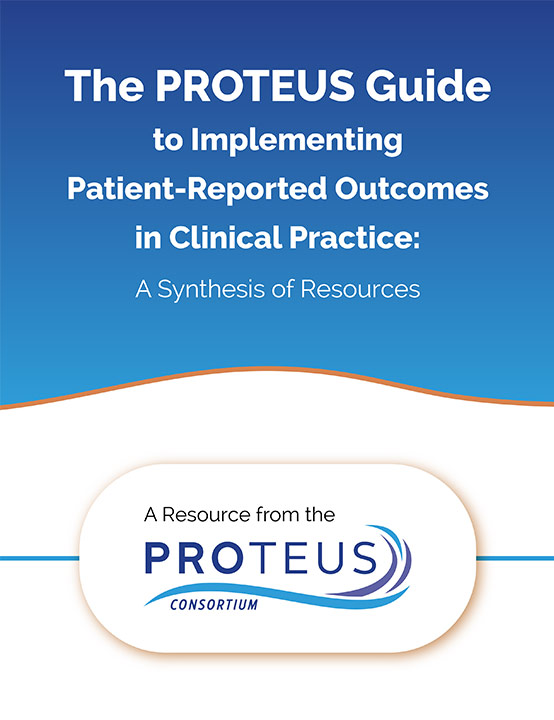PROTEUS — PRACTICE
Incorporating in Clinical Workflow: Chapter 8
In this excerpt (Chapter 8) from the PROTEUS-Practice Guide, you’ll consider how and when patient-reported outcome measures (PROMs) can be added to a clinical practice workflow.
This webpage contains the entire contents of Chapter 8. You can also download the PROTEUS-Practice Guide by clicking here.
Key Points
- Designing a clinical workflow that efficiently captures and addresses patient-reported outcome (PRO) data requires evaluating the current workflow and identifying the points where the workflow must be altered to facilitate the use of patient-reported outcome measures (PROMs)
- While the specific tasks associated with any given PRO system will vary across settings, universal activities include deploying, collecting, tracking, reviewing, and documenting PROMs and PROM scores
- Following implementation science frameworks and approaches can improve the quality of PRO system integration into a clinical workflow
Overview
There are numerous considerations for integrating a PRO system into an existing clinical workflow. At the broadest level, initiatives to incorporate PROs into the workflow should start by clarifying how PRO data will be used (including to inform decisions within and outside of direct patient care), and identifying resources needed for integrating PROs into the workflow. Designing a workflow that efficiently captures PRO data requires evaluating the current workflow and identifying points in this workflow requiring modification for PRO system integration.
Some examples of good practices in the development of PRO systems include incorporating principles of user-centered design, connecting with people with relevant skills/experience in systems engineering or workflow design, conferring with other institutions that are using a similar system, and conducting pilot testing and formative evaluation of the system before full implementation.
While the specific tasks associated with a PRO system will vary across settings, there are five universal key activities. These include deploying PROMs to patients for completion, collecting PROMs from patients, tracking whether PROM data is missing, reviewing how the clinical team accesses PRO information, and documenting how PRO data are catalogued for future reference. These core activities may be adapted to align with the existing clinic workflow. Potential barriers to address, as well as metrics to evaluate the effectiveness of the PRO system, can be considered for each of these activities.
Incorporating PROs into a clinical workflow is largely an exercise in implementation. Common stages in the implementation of any new intervention include planning, designing, developing, implementing, and sustaining. Several implementation science frameworks can be applied to improve the integration of a PRO system into a clinical workflow.
Questions and Considerations
A. What are the initial considerations for incorporating PROs into the clinical workflow?
Clarify why and how PRO data will be collected for patient care
- Knowing the goals and purpose of a PRO system can inform the workflow design (see Chapter 1 on Defining Goals)
Identify resource needs for integrating PROs into workflow
- Typical resources needed include training, decision response resources, personnel, financial support, information technology/technical support, and physical space
Consider whether/how PRO data will be used outside of direct patient care
- For instance, if using PROs for billing and contractual reporting, they must be reflected in patient records
B. How do you design a workflow that efficiently captures PRO data?
Begin by planning
- Document existing workflows
- Identify updates needed to current workflow to include PROM collection
- Develop protocols for how PRO data will be communicated to care team members
- Collect feedback and iterate process as needed
Use good practices in designing the PRO system
- Incorporate principles of user-centered design
- Present and display PRO data to promote the clinical team’s ability to include it efficiently and meaningfully in their decision making
- Conduct usability testing of the PRO system across different end-users (patients, clinical care teams, information technology)
- Conduct formal pilot testing prior to system-wide rollout
- Allow time for modification based on experience, or develop a clear plan for receiving feedback and adapting accordingly
- Confer with other institutions who have developed similar systems to understand their experiences
- Work with information technology to understand technological functionalities available
- Design a system that does not require end-users to log into a new system/platform
Design a system around five key activities
Adapted from ePROS in Clinical Care website.
- There are five key activities that should occur in any PRO system implementation
- Deploy PROMs to patients for completion
- Collect PROMs from patients
- Track whether PROM questionnaire forms are missing
- Review how the clinical team accesses PRO information
- Document how PRO data are catalogued for future reference
- These core activities may be adapted to align with the existing clinic workflow
Figure 8.1: Steps to incorporate PROs into the clinical workflow

C. What are potential barriers to integrating PROs into the workflow?
Barriers to integrating PROs into the workflow vary across the PRO system implementation activities. Below are example barriers for each activity:
- Deploy: clinical team member does not know that PROM is due; team member does not send PROM to patient
- Collect: patient does not have access to patient portal/electronic materials or ability to complete PROMs
- Track: PROM scores do not go to the appropriate team member; results do not get updated in time to inform clinical care
- Review and Document: care team does not know how to locate PROM scores; PROMs do not contain relevant clinical information; PROMs scores are not saved in the record
D. How do you evaluate whether the PRO system is well integrated into the workflow?
- Engage in routine implementation monitoring to improve workflow over time
- Evaluate the system using quantitative metrics, including:
- Deploy: Percent of patients who receive notification to complete PROM
- Collect: Percent of patients who submit PROMs
- Track: Percent of PRO items missing within questionnaires and total questionnaires missing
- Review and Document: Percent of PROM questionnaires that are correctly documented by the clinical team
- Evaluate the system using qualitative methods: conduct formal interviews, usability tests
- Evaluate the system using informal methods: ask patients, clinical team members, administrators, information technology specialists what is and is not working for them
E. What can implementation science teach us about incorporating PROs into a clinical workflow?
- Incorporating PROs into a clinical workflow is an implementation strategy. Common stages in the implementation of any new intervention include planning, designing, developing, implementing, and sustaining
- Several implementation science frameworks can be applied to integrating a PRO system into a clinical workflow. Examples include:
- Structured Analysis and Design Technique (SADT): approach to modeling a workflow that looks for commonalities across diverse environments; describes the core workflow activities, inputs, outputs, controls, and mechanisms for how activities are accomplished
- Lean Management: performance improvement tools that can optimize complex workflows
- Institute for Healthcare Improvement Model for Improvement: guides teams to improve outputs using repeated, small-scale Plan-Do-Study-Act cycles
- Proctor’s Outcomes for Implementation Research Model: provides a framework for aligning implementation process, healthcare, and patient experience outcomes
- Consolidated Framework for Implementation Research (CFIR) Model: identifies implementation factors that impact program adoption and outcomes
- Non-adoption, Abandonment, Scale-up, Spread, Sustainability (NASSS) Framework: guides the identification of challenges and approaches for addressing them using non-adoption, abandonment, and sustainability principles
Relevant Primary Resources
The information presented here is an overview of incorporating PROs into the workflow. For more detailed information please see the following sources:
Background And Citing The Proteus-Practice Guide
Nothing in this Guide should be construed to represent or warrant that persons using this Guide have complied with all applicable laws and regulations. All individuals and organizations using this template have the responsibility for complying with the applicable laws and regulations or regulatory requirements for the relevant jurisdiction.
Each chapter of the Guide lists the key foundational resources that informed its content. To appropriately recognize the foundational resources, we encourage you to cite both the Guide and the relevant foundational resource(s). Recommended citations are provided here.
Suggested Citation
The PROTEUS Guide to Implementing Patient-reported Outcomes in Clinical Practice
A synthesis of resources. Prepared by Crossnohere N, Brundage M, Snyder C, and the Advisory Group, 2023. Available at: TheProteusConsortium.org.
Further Reading
The Guide draws primarily from the foundational resources cited in each chapter. Please click here to find a selection of other relevant references.


